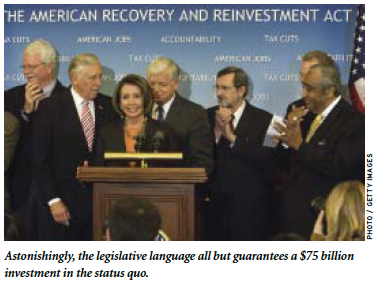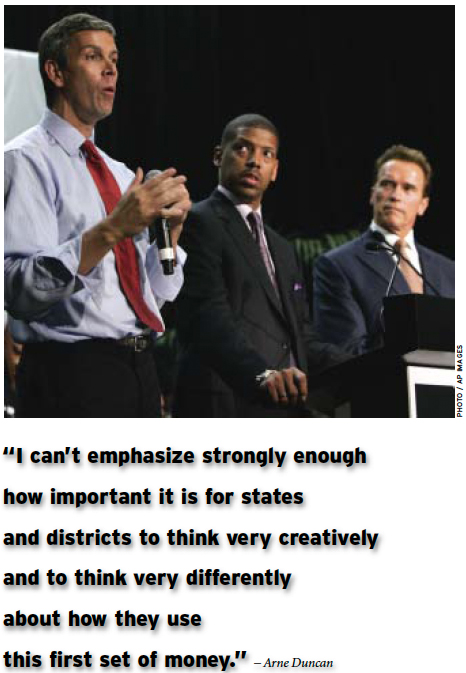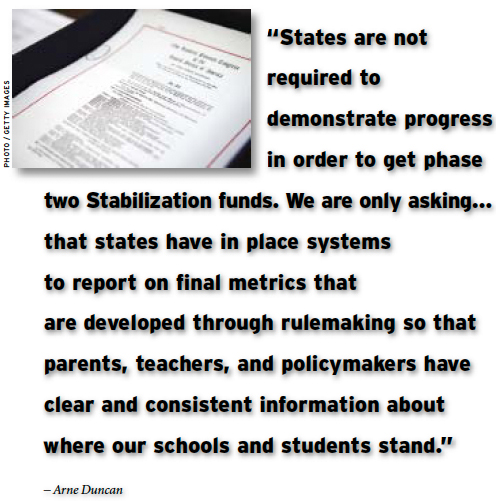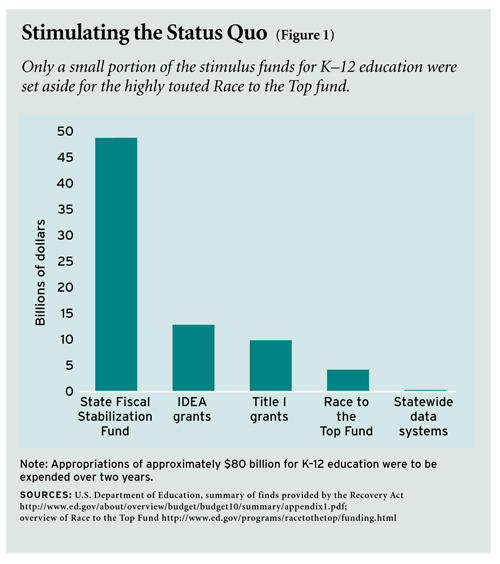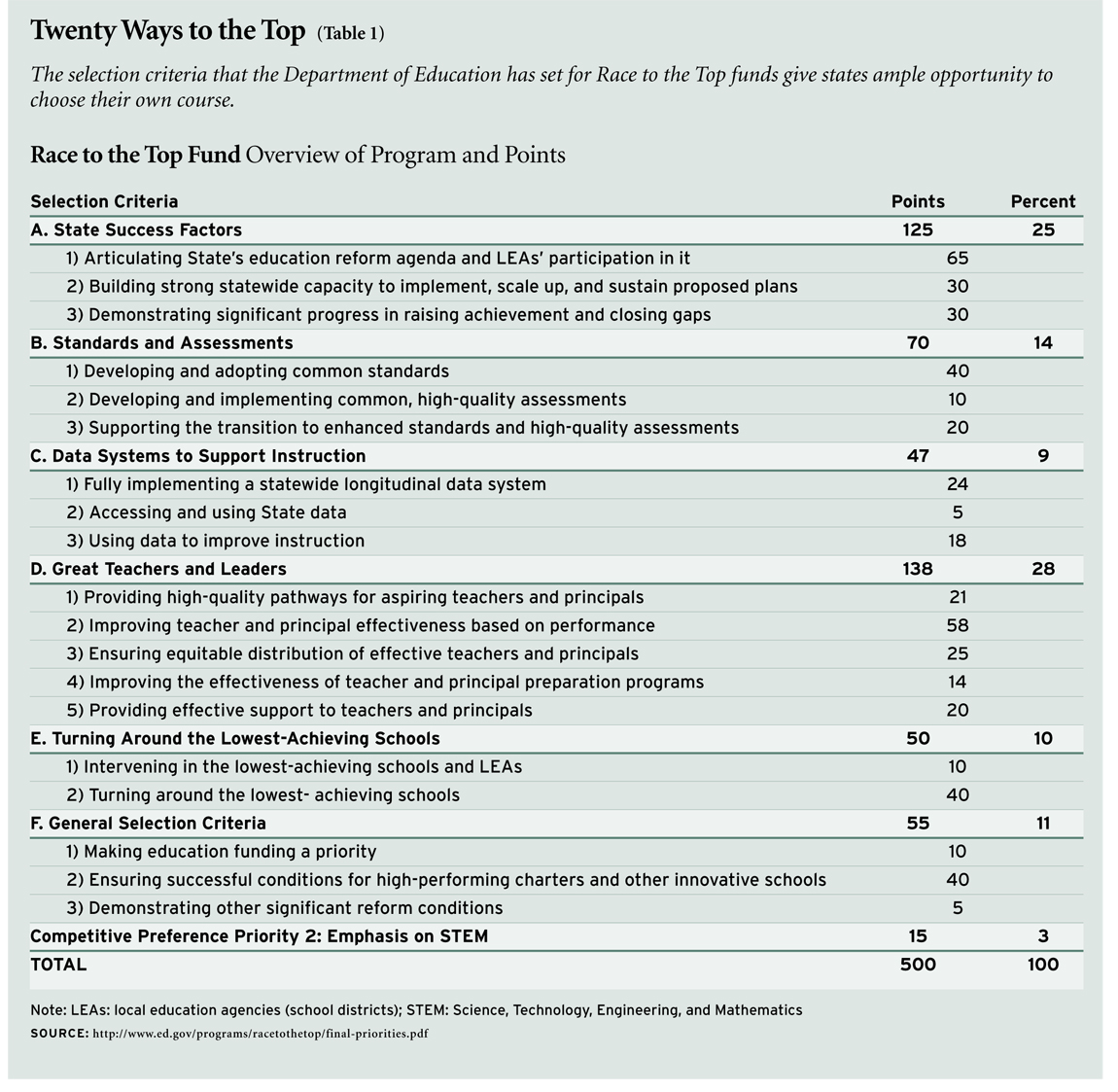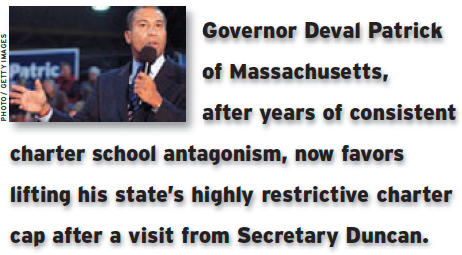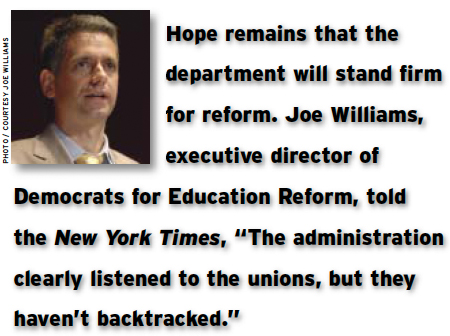Video: Andy Smarick talks with Education Next

To many education reformers, the passage of the federal government’s massive stimulus plan, the American Recovery and Reinvestment Act (ARRA), appeared to be a final bright star falling into alignment.
For years, consensus had been building across the political spectrum that the nation’s schools, especially those in urban America, were in urgent need of fundamental change. The election of reform-friendly Democrat Barack Obama presented the opportunity for K–12’s Nixon-goes-to-China moment. The subsequent selection of Arne Duncan, the battle-tested former Chicago schools chief, as secretary of education provided a trusted, steady hand to lead the charge and take the flak.
The ARRA seemed to complete the constellation: an astounding $100 billion of new federal funds—nearly twice the annual budget of the U.S. Department of Education—to jump-start and sustain the improvement of America’s schools. When Duncan expressed his intention to make the very most of this once-in-a-lifetime “moon shot,” some advocates eagerly prophesied an epochal shift for reform.
The ARRA’s results to date, however, have been soberingly quotidian. So far, the vast majority of its funds have served to sustain the status quo, funding the most traditional line items and actually helping schools and districts go about their everyday business. With one notable exception (spurring long overdue changes in some state laws), the implementation of this mammoth statute has confirmed several humbling, hoary lessons of federal policymaking, including the limited ability of Uncle Sam to drive education reform.
Though deflating (not to mention terribly expensive), these bumps and bruises, if taken to heart, could help build a better understanding of the federal government’s inherent strengths and weaknesses in K–12 education policy, a particularly valuable exercise as NCLB reauthorization looms. As important, they could still have a critical influence on the ARRA itself—helping to salvage its crown jewel of reform, the vaunted Race to the Top (RTTT).
Easy Money
The ARRA was crafted during the darkest stage of the recession and signed into law in February 2009. To help revive the nation’s flagging economy, Congress and the administration were determined to have funds enter the financial bloodstreams of states and districts as quickly as possible. So about $75 billion of the $80 billion the law designated for K–12 schools was funneled through formula-based programs, including the Individuals with Disabilities Education Act (IDEA) and Title I, two of the nation’s oldest and most familiar federal education funding streams. Simply by virtue of having students, states and districts would begin receiving funds. No grant competitions, no long, complicated applications, no review teams with complex scoring rubrics.
The lion’s share of these ARRA education dollars was appropriated through the new $50 billion State Fiscal Stabilization Fund (SFSF), a population-based program created to expeditiously replenish education budgets decimated by declining tax revenue.
Despite the priority placed on getting lots of money out on the double, some policymakers were determined to see that these funds were also well spent. So the legislation required that, in advance of receiving their SFSF allocations, governors sign “assurances,” statements promising that their states were taking action to improve teacher quality, develop better data systems, enhance standards and assessments, and address low-performing schools. Duncan went even further, repeatedly telling state leaders that these formula dollars had to be used to improve student learning and innovate, not merely fund more of the same.
States that spent the funds unwisely, the secretary warned in March 2009, would seriously compromise their ability to vie for the $5 billion of ARRA competitive grants. “States that are simply investing in the status quo will put themselves at a tremendous competitive disadvantage for getting those additional funds,” Duncan said. “I can’t emphasize strongly enough how important it is for states and districts to think very creatively and to think very differently about how they use this first set of money.” The department also took the unusual step of creating a document for state and district leaders that explained how these funds could be used in reform-oriented ways.
Had everything gone according to Hoyle, this massive infusion of federal funds would have protected state and district education budgets from major cuts while advancing invaluable reforms by supporting new, innovative, and promising programs. But as is often the case in education policy, the best laid plans of Uncle Sam went awry.
In a July 2009 report to Congress, the Government Accountability Office (GAO) found that SFSF dollars were being used to protect the status quo. After studying a sample of 16 states and select jurisdictions within them, GAO reported that federal funds were in fact being used for “retaining staff and current education programs.” Instead of advancing important reforms, states and districts were addressing a “more pressing” matter—their fiscal needs. In discussions with district leaders, GAO found that “most did not indicate that they would use [SFSF] funds to pursue educational reforms”; instead, they wanted to fill their existing budget holes. For example, officials in Flint, Michigan, decided to use SFSF funds to “cope with budget deficits rather than to advance programs.” Miami-Dade planned to save 2,000 teaching jobs; Richmond County in Georgia funded teachers, paraprofessionals, media specialists, and other existing positions.
Then, in an August report that the Washington Post referred to as a “reality check,” the American Association of School Administrators (AASA) also found that funding was being used to protect jobs and programs. The survey of administrators reported that most of the funds were merely repairing budget holes and that little if any reform was being accomplished. “Everybody appreciated getting the money,” the association’s executive director told the Christian Science Monitor, “but primarily all the money did was help to backfill the budget deficits they were already facing.”
The single-minded focus on jobs and the status quo was confirmed by hard numbers. In September, the U.S. economy lost 190,000 jobs, but the education sector gained nearly 11,000 jobs. In October, the Obama administration announced that more than half of the 640,000 jobs created or saved across the entire economy by the ARRA were in education. In November, after studying states’ quarterly stimulus reports, Education Week found that 96 percent of the ARRA education funds spent to that point had been “focused on creating and saving jobs.”
How did one of the ARRA’s education goals (reform) get completely displaced by the other (job and program preservation)? The answer can be found in two sets of factors, one mostly economic and beyond the federal government’s control but the other legislative and fully within it. Combined, they offer an unmistakable overarching lesson: local dynamics, not the will of Washington, determine the pace and scope of education reform.
The greatest confounding factor was the severity and duration of the nation’s financial decline. Revised 2009 figures indicated that the U.S. economy had contracted twice as much as previously estimated, amounting to the largest downturn since the Great Depression. Nationwide, unemployment topped 10 percent in October, considerably higher than most experts had anticipated.
State budgets were drastically affected. California famously faced a $26 billion shortfall, but many other states, including Ohio and Illinois, confronted multibillion-dollar deficits as well. A University of Denver study declared that Colorado’s government had been hit by a “budgetary tsunami.” The chair of Alabama’s finance committee called the state’s financial crisis “worse by far than we’ve ever seen it.” One estimate predicted that, were the recession to end in 2009, the states would still have combined deficits of $230 billion, comparable to the entire gross domestic product of Singapore.
Regrettably, but predictably, education systems went into self-preservation mode. Part of the explanation can be found in districts’ DNA. Local education systems, particularly the largest urban districts, are infamously Byzantine, change-averse organizations. They are also generally among their communities’ largest employers. Notably, both the GAO and AASA studies reported that local school officials felt compelled to disregard the calls for reform given “the realities of strained federal, state, and local budgets,” and the resulting likelihood of layoffs and other cuts.
External forces exacerbated these internal tendencies. In some cases, unions pressured policymakers to direct funds toward job protection. The California Teachers Association organized a “Pink Friday” rally to protest pink slips and furloughs. In Michigan, a local union sued a district over layoffs. Some in Montana sought to use stimulus funds to shore up teacher pensions, and the Utah Education Association ran television ads urging legislators to dedicate ARRA dollars to restoring education programs.
As a number of commentators have noted, the economic downturn offered school systems the opportunity to alter expensive, outdated practices such as strict salary schedules, protective tenure rules, and bloated pension programs. Though sensible in theory, this was probably wishful thinking when applied to the often confounding realities of K–12 politics and policy. Indeed, Kevin Carey, of the Washington-based think tank Education Sector, has written that there is no evidence that districts “implement a whole suite of needed reforms” in response to recessions.
Carey’s argument is strongly supported by recent events. In instances where stimulus funds failed to fill budget holes completely, states and districts generally did not blaze a trail for reform, instead opting for temporary, shortsighted cuts designed to help them hunker down and ride out the current storm. A number of states instituted flat reductions in district aid, while others made across-the-board cuts to programs. California’s Saddleback Valley district cut athletic programs, while districts from Houston to Boston to Atlanta slashed bus service. Seattle-area schools eliminated groundskeeper positions, Prince George’s County in Maryland cut “parent liaisons,” and Illinois reduced spending on bilingual and early-childhood programs. There was a nationwide trend in summer-school reductions, and Hawaii cut school days. Lake Washington School District in Washington had teachers remove microwaves from their rooms to reduce energy bills. In total, it appears that when education budgets wane, schools’ survival instincts, not their reform inclinations, kick in.
Though the course of the recession, local political dynamics, and district preferences were beyond the reach of federal policymakers; the contours and implementation of the ARRA were not. They could have factored in these considerations to craft and administer a plan more likely to bring about reform. Astonishingly, however, the legislative language and departmental pronouncements enabled—actually, all but guaranteed—this $75 billion investment in the status quo.
While the use of formula-based programs certainly facilitated the speedy distribution of funds, it also set the stage for conventional spending patterns. In the case of Title I and IDEA, states were provided grants under their existing program agreements, meaning the federal government provided billions without extracting new reform promises.
Guidelines made clear that these funds had to be used in ways consistent with long-established program requirements. But over decades, tens of billions of dollars have flowed through these programs, failing to generate the improvements needed. Instead of tying new dollars to specific reform-oriented strategies, the law required that they fund more of the same.
Even more trouble was embedded in the SFSF. The law stipulated that states first use their allotments to fill budget holes and, instead of giving states the opportunity to reconsider their allocation of resources, it mandated that they use their existing funding formulas. So, rather than requiring or even encouraging state leaders to use this $50 billion investment to pursue new projects and ways of thinking, the ARRA prioritized preservation of the current order.
If dollars remained after budget holes had been filled, states were not allowed to invest them in new reform initiatives; they had to distribute what was left to the districts by formula. Districts then had nearly unfettered control over how these funds were spent; activities merely had to comport with four major federal education statutes, including the Elementary and Secondary Education Act—laws that, despite many years and billions invested, hadn’t adequately improved our schools.
Congressional leaders could have empowered governors, often among the nation’s leading education reformers, to direct how portions of these funds were used. Instead, federal guidance made clear that governors and state superintendents were prohibited from doing so.
Finally, meaningful federal oversight was lacking. States were not required to provide advance details of how dollars would be spent. The applications approved by the department are staggeringly devoid of specifics. While governors had to sign a form committing their states to pursuing four general areas of reform, these assurances carried little weight. States could receive their first allotments without explaining how the funds would actually be spent, and, amazingly, states could receive their second allotments even if they hadn’t followed through on their promises. In an April 2009 letter to governors, Secretary Duncan wrote, “States are not required to demonstrate progress in order to get phase two Stabilization funds. We are only asking…that states have in place systems to report on final metrics that are developed through rulemaking so that parents, teachers, and policymakers have clear and consistent information about where our schools and students stand.”
In retrospect, it’s easy to see why the new federal funds didn’t lead to reform. Though $75 billion now appears to be a lost cause, it did buy important lessons. If properly applied, these lessons could contribute mightily to the ARRA’s final major education initiative.
As expectations for the formula-based stimulus funds have rightfully abated, hopes for the reform-driving Race to the Top fund have risen. At $4.35 billion, RTTT is petite compared to other ARRA programs, but as a competitive grant program, it represents by far the largest amount ever at the discretion of an education secretary (see Figure 1).
The administration has tried to make the most of this opportunity by identifying specific reform priorities and requiring interested states to craft proposals that respond to each (see Table 1). While some roundly criticized the department’s audacity—former assistant secretary of education Diane Ravitch called the strategy embedded in the department’s draft documents “coercive” and North Carolina governor Beverly Perdue described it as “prescriptive”—others believed this would ensure the wise investment and use of these funds. That is, if a state doesn’t agree with the department’s favorite reforms, it simply won’t apply; if a state does agree, it will devise the strongest possible plan that faithfully responds to all priorities.
Unfortunately, that’s unlikely to be the case. First, because states are still desperate for money, it’s doubtful they will take a pass on the opportunity to compete for several hundred million dollars. In fact, a month before the first filing deadline, no state had announced that it would forgo the entire competition. Moreover, states’ financial fortunes are expected to get worse.
State budgets typically suffer most in the year after a recession ends. The Rockefeller Institute has found that education spending remains depressed several years after economic growth returns. These effects could be even more pronounced this time. Nationally, property taxes still account for 30 percent of all school revenue. The recession and associated housing crisis have significantly depressed property values; according to one widely used index, home prices declined continuously for three years beginning in July 2006. As rolling assessments catch up with these reduced prices, property tax revenues are likely to be adversely affected. An August report from the National Conference of State Legislatures noted, “While Fiscal Year 2009 can be summed up in one word: dismal, FY 2010 can be characterized by two words: even worse.” The National Governors Association and National Association of State Budget Officers concur: governors’ 2010 budget submissions showed the largest general fund reductions since 1979.
Second, federal dictates don’t alter local preferences; they only force them into temporary hiding. Yes, governors signed the ARRA’s reform assurances but states didn’t use SFSF dollars for reform. Yes, states developed standards and assessments as No Child Left Behind (NCLB) required, but many adopted weak standards and set low cut scores. Yes, districts developed policies for NCLB public school choice and supplemental education services, but they cleverly thwarted the full implementation of these programs, evidenced by the shockingly low student participation rates. As others have noted, the federal government can make states and districts do what they don’t want to, but it can’t make them do it well.
We know that states and districts desperately need money, that they have a preference for preserving the status quo, and that when the federal government asks them to do things they’re not fond of, they may just go through the motions. So when the U.S. Department of Education places $4.35 billion on the table during a serious recession and tells states to respond to Washington’s favorite ideas, it would be wise to anticipate their responses with a stockpile of skepticism.
The ultimate challenge for the administration will be reducing the gulf between reforms promised and reforms delivered. Among actions deserving a raised eyebrow are the modifications made to state laws since the passage of the ARRA. Duncan ingeniously used Race to the Top to induce states to improve their policies. If you want a grant, said the secretary, your state had better be hospitable to reform. The swift and positive response from the states amounts to the greatest achievement of Secretary Duncan’s tenure: Illinois, Louisiana, and Tennessee lifted charter school caps. California and Wisconsin ended prohibitions on linking student performance data to individual teachers. Delaware passed legislation making the state more hospitable to Teach For America, and Rhode Island put a stop to all seniority-based teacher assignments. A number of states, including Massachusetts and Michigan, were hurrying to make legislative changes before the first submission deadline in January, and others, including Maine, Maryland, Nevada, and Washington, were planning to apply in the second round to give their legislatures time to pass reform laws.
But as discussed above, there’s considerable daylight between a reform-oriented policy and its faithful implementation. The department should remember that while many states permit linking teachers to student test scores, few districts actually do so, and that while Virginia and Mississippi have each had a charter law for more than a decade, combined they have only five charter schools. In November, Tennessee provided a perfect and alarming example of how this might play out with regard to RTTT: though the state lifted its charter cap as Duncan desired, in the span of two days Memphis and Nashville denied all 24 charter applications submitted to them.
A good leading indicator of whether a state’s heart will actually be in its reforms is whether it sees the RTTT as an engine for change or as bags of cash. Secretary Duncan has said that the program “is not about the money,” and that “If folks are doing this to chase money, it’s for the wrong reasons.” But there have been numerous indications that the potential for a titanic federal payday is a huge, if not the decisive, consideration for many. Maybe the starkest case came from Massachusetts, where Governor Deval Patrick, after years of consistent charter school antagonism, conducted a high-profile volte-face and announced his support for lifting his state’s restrictive charter cap. This occurred after a visit from Secretary Duncan and a reminder that the Bay State was on the brink of disqualifying itself from RTTT consideration.
There are plenty of other examples. Illinois governor Pat Quinn said, “We want to get Illinois in that race and make sure we get as much money as possible from Washington.” The spokesperson for Idaho’s department of education noted, “Race to the Top is the only opportunity for education to get additional funding over the next two to three years.” A lobbyist for the California School Boards Association said, “The money would be nice because of our budget situation.” Even Ohio’s reform-minded Senator John Husted said, “During these tough and uncertain financial times, I believe it is imperative that Ohio be in a strong position to take advantage of the Race to the Top dollars.” A Wisconsin legislator angry about the lack of teeth in an ostensibly reform-oriented piece of legislation may have spoken for many when he said, “This is basically a race for the money, not a race for the top.”
Also to be approached with suspicion are the promises that will appear in state applications. To satisfy the administration’s requirements, states will have to change policies affecting teachers, intervene in failing schools, support charters, and more. With so much money at stake, we should expect carefully assembled plans that convey earnest guarantees of reform. But the SFSF assurances taught us the hard way that reform commitments plus a governor’s signature do not necessarily equal real reform.
So when state proposals hit Arne Duncan’s desk, the secretary must become the toughest schoolmarm in America. The first step is to not reflexively reward the states that improved their policies in response to the RTTT carrot. The department should instead view such moves cynically. Had these states really believed in reform, they would have adopted these measures ages ago. Deathbed conversions are always suspect.
Lifting a legislated charter cap shouldn’t be enough. There should be proof that state and district officials are not inhibiting charter growth, that new schools are opening, and that they have the requisite flexibility and funding to thrive. Likewise, a new law that brings down a “data firewall” should be coupled with affirmative policies that link individual test scores to individual teachers in the state data system and watertight district policies that tie this new information to tenure and evaluation decisions.
When a state promises in its RTTT application to develop a new teacher-preparation system, the administration must pry: Is this really a new initiative or just a renaming of your existing certification process? When a state proposes to create a major new intervention for failing schools, the department must confirm that this isn’t just gussying up an old and meek school improvement strategy.
As important, the department must insist that all reform proposals be completely shovel-ready upon submission. A state’s promise to launch a performance pay system is meaningless unless all pieces of the supporting architecture are already in place. That means the state legislature has authorized the program, union contracts have been modified to allow it, data systems have been updated to support it, and a state disbursement process is prepared to allocate funds as soon as the federal grant arrives.
There is some reason to wonder just how tough the department will be. Though the final documents released in November are still laudable, they certainly represent a step back from the publicly released draft versions. States can score points for a charter law with a cap. A state without a charter law can score points with a pale facsimile of one. A performance-pay system plays a smaller role than many expected. The door was opened to weak interventions for failing schools. And, possibly most curiously, despite Duncan’s earlier warning that a state’s unwise use of early ARRA funds would cause it to be tremendously disadvantaged in the RTTT competition, this issue only comprises 1 percent—5 of 500—of the total points available (by comparison, not signing on to the common standards initiative would cost a state 8 times the number of points). These shifts were widely noticed. In an editorial titled “School Reform Retreat?” the Wall Street Journal noted that the administration had eased requirements, and the Washington Post editors wrote bluntly, “draft regulations have been weakened.” Equally instructive was the national teachers unions’ support for the changes.
Despite these shifts, hope remains that the department will stand firm for reform. Joe Williams, executive director of Democrats for Education Reform, told the New York Times, “The administration clearly listened to the unions, but they haven’t backtracked.” As the first competition got underway in the fall, Secretary Duncan maintained that the bar will be “very, very high,” telling Education Week, “There will be a lot more losers than winners.”
In hindsight, perhaps Washington should have crafted a different education package for the ARRA. Under alternate circumstances, federal leaders might have recognized that stabilizing and reforming our schools are quite different goals and that the complications associated with driving education reform from the nation’s capital are at least equal to the opportunities. But in early 2009 the economy’s condition didn’t afford much time for deliberation, and in the wake of the historic 2008 elections, few ascendant federal policymakers were overflowing with modesty and prudence.
Much will be learned from these experiences in the years ahead, but for the time being one immediate takeaway merits repeating: Local policy prerogatives and dire financial conditions trumped federal pleas for reform and led to the spending of massive amounts of aid on preserving the status quo and protecting existing jobs and programs.
With similar factors coalescing around RTTT, the administration should be wise to the potentially regrettable outcomes absent additional protections. Moving forward, the administration might reconsider talk of “moon shots” and transformational change and instead adopt a more humble creed: Fool me once, shame on you; fool me twice, shame on me.
Andy Smarick, a former U.S. deputy assistant secretary of education, is a distinguished visiting fellow at the Thomas B. Fordham Institute and adjunct fellow at the American Enterprise Institute.


